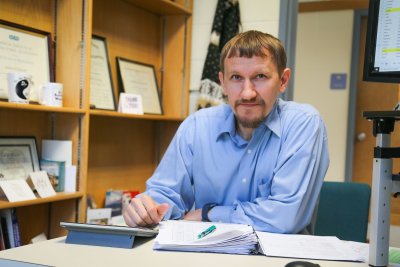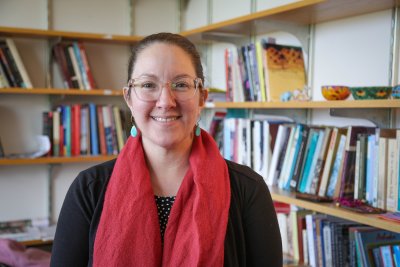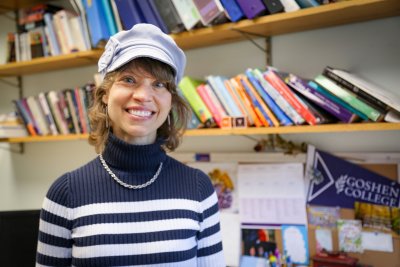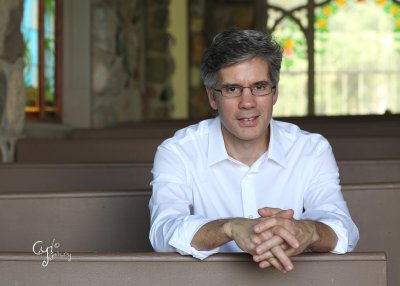Where faith & learning connect: Faculty
What sets Goshen College apart from almost all of the other thousands of colleges and universities? One needs only to look as far as our mission statement for the answer: “Shaped by Anabaptist-Mennonite tradition, we integrate academic excellence and real-world experience with active love for God and neighbor.”
This is a place where faith and learning connect, and where each profoundly informs the other. In a broken world that longs for better questions and new answers, we believe that graduating students prepared to go out and to engage the complexity with both wisdom and wonder is just what is needed.
You might wonder: What does that look like? How does it happen? How does that impact our graduates? Hear from a few of our faculty members for a glimpse of their experiences.
 Andrew Hartzler ‘98
Andrew Hartzler ‘98
Professor of Accounting
“For me, my faith is an inseparable part of who I am. Faith is not about a set of tenets, a rigid set of rules, it is intricately connected to the design of who we are as human beings. The goodness of God is woven into the fabric of who we are. In the course of our lives that fabric gets torn and dirtied at times, but the imprint of God is there, always waiting to be revealed.
The essence of who God is to me is embodied in the kindness, compassion, joy and love we find in our human experience. When I enter the classroom, I am keenly aware of the fact that I am in the presence of other human beings who are simultaneously broken and beautiful. Each day I look for ways to share a transparent, raw, and authentic kindness, compassion and joy with these young people with whom I’ve crossed paths. As badly as I want each moment in the classroom to be joy filled, I recognize that we all go through dark times and struggle. It is when I see that darkness (stress, issues with family/friends, etc.) welling up in my students or in myself I name the light that faith is for me in those moments. I encourage them to pursue the light that the darkness can never extinguish.”
 Dr. Julia Schiavone Camacho
Dr. Julia Schiavone Camacho
Associate Professor of History
“My first years teaching at a Christian college have been an exercise in shedding secular ways and getting used to bringing my whole self to teaching. After attending Catholic schools for most of K-12, my higher education experience both as a student and later as a professor was secular, until I started teaching at Goshen College. It has been a revelation, and a meaningful part of my faith journey to be able to discuss spirituality and to invite students to pray or meditate and share from their journeys in certain situations. In some of my classes we have the opportunity to consider how faith, spirituality and religion have shaped human history. In seeking new ways to integrate faith and learning, as I go forward, I have been considering how I could make deeper, structural changes that draw on the ways my faith and identity as a Catholic who is teaching at a Mennonite institution informs the deeper roots of each course I teach at GC.”
 Dr. Julie Reese
Dr. Julie Reese
Professor of Psychology
“How do I bring faith and learning together? Each morning, I read the Bible, pray, and ask God to prepare me to share His truth and love. My discipline, psychology, naturally involves values, behaviors and relationships, fruitful areas to discuss how humans have inherent value and responsibility as image-bearers of God. I try to point out the “what is” in the world as opposed to the “what ought” in the Word. I seek to highlight how psychological findings often align with the message of the Bible. Since the beginning of the psychology major, Senior Seminar has been a required course where we discuss explicit issues of faith and psychology. Students select topics ranging from forgiveness to prayer in therapy to religious abuse and beyond. They lead the discussion, where all do readings in preparation for class, and I join in as a participant. Students have expressed deep appreciation for the space to discuss and wrestle with such issues in an academic context, beyond just sharing personal opinions. As I enter my third decade of teaching, I am more intentional in bringing faith into the classroom. I begin each Friday with part of a Psalm and a prayer, emphasizing the invitation to have faith conversations with me outside of class.”
 Dr. Matthew Hill
Dr. Matthew Hill
Professor of Music
“‘This is my beloved Son, listen to him!’ Thus spoke God at the moment of the Transfiguration. Music is a means of listening to Him who is the fullness of truth, life and beauty. It can act as a type of “real presence” whereby the mystery of God’s eternal wonder can be sensed through the beauty of meaningful sound. This reality of music’s ever deepening ability to communicate is what allows me to profoundly unite my Catholic faith with the teaching of the art of music.
Since antiquity, music has been associated with an otherworldliness, with liturgical form, with worship and in all cultures, as expressing the totality and mystery which makes up our humanity. Music gives evidence to the infinite — a form of expression that is ever deepening. Gregorian chant, the symphonies of Beethoven and the operas of Verdi puts us in contact with a “presence” that makes us aware of that which is greater than ourselves. Music asks “Who do you say that I am?!” So powerful for students, and all of us, to grapple with this question. We do this through daily practice, through study, through listening, in silence and ultimately in performance, where its meaningfulness reminds us, that the beauty we encounter is only a gentle preparation for that which God has in store for those who love.”




